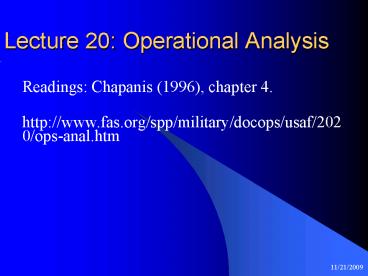Lecture 20: Operational Analysis - PowerPoint PPT Presentation
1 / 21
Title:
Lecture 20: Operational Analysis
Description:
http://www.fas.org/spp/military/docops/usaf/2020/ops-anal.htm. 11/9/09. Goals ... monitor sonobuoys from a helicopter better with a 4- or an 8-channel receiver? ... – PowerPoint PPT presentation
Number of Views:85
Avg rating:3.0/5.0
Title: Lecture 20: Operational Analysis
1
Lecture 20 Operational Analysis
- Readings Chapanis (1996), chapter 4.
- http//www.fas.org/spp/military/docops/usaf/2020/o
ps-anal.htm
2
Goals
- Introduce the human factors methods required to
support the basic system development activities
of - analysis,
- design,
- testing.
- Standards, Guidelines and Principles cant do it
all
3
Human Factors Methodologies
- protect (to some extent) against subjectivity and
narrow-minded thinking. - document the rationale behind a human factors
intervention or design process. - provide a method of analyzing systems.
- yield data about human performance.
- generate predictions (sometimes useful) about
human-system performance. - provide a basis for evaluating whether or not
performance using a human-machine systems meets
design criteria.
4
Applied research
- looks at more specific situations.
- asks the question, "Can people do this exact
task under these special conditions? - e.g., "Can sonar operators monitor sonobuoys
from a helicopter better with a 4- or an
8-channel receiver?". - "What information, what work product, does this
method provide that I can use in the design of
some specific thing?"
5
Operational Analysis
- "An operational analysis is an analysis of
projected operations to obtain information about
situations or events that will confront operators
and maintainers in using a new system. It
typically contains scenarios, verbal descriptions
of events, and summarizes anticipated
operations, assumptions, and environments."
6
Inputs for Operational Analysis
- information in RFPs (requests for proposals)
- planning documents
- system requirements provided by customer
- system requirements provided by experts
7
Outcomes/Deliverables
- list of system operational and maintenance
requirements - Descriptions of assumed operations
- list of operations that appear feasible and those
that may overstress the system - list of environmental factors that may affect
system performance - list of constraints, e.g. personnel and training,
that may affect system performance - list of foreseeable failures and evaluations of
the consequences of those failures
8
Analysis of Similar Systems
- One or more observational methods are used to
discover salient features of systems that are
similar to the one under consideration, with the
expectation that this will provide useful
information for design.
9
Inputs for Analysis of Similar Systems
- Structural observations
- Interviews
- Questionnaires
- Activity analyses
- Critical incident studies
- Accident investigations
10
Attributes of Interest
- Data on the operability of the older system
- maintainability of the older system
- Numbers of people required to staff the system
- Skills required to operate and maintain the
system - Training required to bring operators to
proficiency - problems encountered in the design of the system
- Problems encountered by personnel in using the
system
11
Places to find Required Information
- productivity records
- maintenance records
- training records
- accident or incident reports
12
Data Collection
13
Critical Incident Analysis
- Mistakes and near-mistakes in reading an
indicator - Mistakes and near-mistakes in using a control
- Mistakes and near-mistakes in interpreting an
instruction
14
Analysis of Control Errors (1947)
- Confusing controls with each other 50
- Control adjustment problems (slow, quick,
incorrect) 18 - Forgetting 18
- Failure to check, unlock, or use at proper time
- Reversal (moving control in wrong direction) 6
- Unintentional activation 5
- Inability to Reach 3
15
Function Flow Analysis
- Identify sequence of functions/actions performed
by system - Uses information from operational analyses,
analysis of similar systems, or activity analyses - Start with system objectives -gt identify
functions - Expand top-level functions into lower levels
containing more information
16
Simple Function Flow (Meal)
- Plan meal
- Obtain food
- Prepare meal
- Consume meal
- Clean and store
17
Zero-Order function flow chart (top level)
- 1. Prepare and present flight briefs
- 2. Assume pre-launch posture
- 3. Perform pre-liftoff function
- 4. Perform liftoff function
- 5. Perform transit out function
- 6. Perform selected tactical function
- 7. Perform transit back function
- 8. Perform recovery functions
18
First-order function flow for Prepare and
present flight briefs
19
Second order function flow
- 1.1 Prepare mission brief
- 1.2.1 Obtain briefing information
- 1.2.2 Present mission data to crew
- 1.3 Review mission preparation
20
Exercise
- Prepare a functional flow diagram showing the
steps involved in preparing for and taking a
vacation trip by automobile. Carry out your
diagram at least to second-level functions.
21
Conclusions
- Operational Analysis examines how the system will
be used. Identifies issues and problems and
generates recommendations for design that
supplement standards, guidelines, etc.































